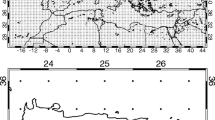Abstract
The seasonal and inter-annual variations of Arctic cyclone are investigated. An automatic cyclone tracking algorithm developed by University of Reading was applied on the basis of European Center for Medium-range Weather Forecasts (ECMWF) ERA-interim mean sea level pressure field with 6 h interval for 34 a period. The maximum number of the Arctic cyclones is counted in winter, and the minimum is in spring not in summer. About 50% of Arctic cyclones in summer generated from south of 70°N, moving into the Arctic. The number of Arctic cyclones has large inter-annual and seasonal variabilities, but no significant linear trend is detected for the period 1979–2012. The spatial distribution and linear trends of the Arctic cyclones track density show that the cyclone activity extent is the widest in summer with significant increasing trend in CRU (central Russia) subregion, and the largest track density is in winter with decreasing trend in the same subregion. The linear regressions between the cyclone track density and large-scale indices for the same period and pre-period sea ice area indices show that Arctic cyclone activities are closely linked to large-scale atmospheric circulations, such as Arctic Oscillation (AO), North Atlantic Oscillation (NAO) and Pacific-North American Pattern (PNA). Moreover, the pre-period sea ice area is significantly associated with the cyclone activities in some regions.
Similar content being viewed by others
References
Blackmon M L. 1976. A climatological spectral study of the 500 mb geopotential height of the Northern Hemisphere. Journal of the Atmospheric Sciences, 33(8): 1607–1623
Comiso J C, Parkinson C L, Gersten R, et al,. 2008. Accelerated decline in the arctic sea ice cover. Geophysical Research Letters, 35(1): 179–210
Gulev S K, Zolina O, Grigoriev S. 2001. Extratropical cyclone variability in the Northern Hemisphere winter from NCEP/NCAR reanalysis data. Climate Dynamics, 17(10): 795–809
Hodges K I. 1994. A general method for tracking analysis and its application to meteorological data. Monthly Weather Review, 122(11): 2573–2586
Hodges K I. 1996. Spherical nonparametric estimators applied to the UGAMP model integration for AMIP. Monthly Weather Review, 124(12): 2914–2932
Hoskins B J, Hodges K I. 2005. A new perspective on the Southern Hemisphere winter storm tracks. Journal of Climate, 18(20): 4108–4129
Julienne C S, Mark C S, Andrew B, et al. 2011. Attribution of recent changes in autumn cyclone associated precipitation in the Arctic. Tellus A, 63:10.1111/tea.2011.63. issue-4: 653–663
Leckebusch G C, Ulbrich U. 2004. On the relationship between cyclones and extreme windstorm events over Europe under climate change. Global & Planetary Change, 44(1): 181–193
Mesquita M D, Hodges K I, Atkinson D E, et al. 2009. Sea-ice Changes in the Sea of Okhotsk: Relationship with Northern Hemisphere Storm Tracks. San Francisco, CA: American Geophysical Union, Fall Meeting 2009 Abstract.
Notaro M, Wang W C, Gong, W. 2006. Model and observational analysis of the northeast US regional climate and its relationship to the PNA and NAO patterns during early winter. Monthly Weather Review, 134: 3479–3505
Orsolini Y J, Sorteberg A. 2009. Projected changes in Eurasian and Arctic summer cyclones under global warming in the Bergen climate model. Atmospheric and Oceanic Science Letters, 2(1): 62–67
Pinto J G, Spangehl T, Ulbrich U, et al. 2006. Assessment of winter cyclone activity in a transient ECHAM4-OPYC3 GHG experiment. Meteorologische Zeitschrift, 15(3): 279–291
Serreze M C. 1995. Climatological aspects of cyclone development and decay in the arctic. Atmosphere-Ocean, 33(1): 1–23
Serreze M C, Barrett A P. 2008. The summer cyclone maximum over the central Arctic Ocean. Atmosphere-Ocean, 33(1): 1–23
Serreze M C, Barry R G. 1988. Synoptic activity in the Arctic Basin, 1979-1985. Journal of Climate, 1: 1276–1295
Screen J A, Simmonds I. 2011. Erroneous Arctic temperature trends in the ERA-40 reanalysis: a closer look. Journal of Climate, 24(10): 2620–2627
Simmonds I, Burke C, Keay K. 2008. Arctic climate change as manifest in cyclone behavior. Journal of Climate, 21(22): 5777–5796
Simmonds I, Keay K. 2009. Extraordinary September Arctic sea ice reductions and their relationships with storm behavior over 1979–2008. Geophysical Research Letters, 36(19): 158–168
Simmonds I, Rudeva I. 2014. A comparison of tracking methods for extreme cyclones in the Arctic Basin. Tellus A, 66, 25252
Sorteberg A, Walsh J E. 2008. Seasonal cyclone variability at 70°N and its impact on moisture transport into the Arctic. Tellus, 60A: 570–586
Stroeve J, Holland M M, Meier W, et al. 2007. Arctic sea ice decline: faster than forecast. Geophysical Research Letters, 34(9): 529–536
Ulbrich U, Christoph M. 1999. A shift of the NAO and increasing storm track activity over Europe due to anthropogenic greenhouse gas forcing. Climate Dynamics, 15(7): 551–559
Uotila P, Vihma T, Pezza A B, et al. 2011. Relationships between Antarctic cyclones and surface conditions as derived from highresolution numerical weather prediction data. Journal of Geophysical Research: Atmospheres, 116(D7):D07109
Wang X L, Swail V R, Zwiers F W. 2006. Climatology and changes of extratropical cyclone activity: comparison of ERA-40 with NCEP–NCAR reanalysis for 1958–2001. Journal of Climate, 19(13): 3145
Wei L, Qin T. 2016. Characteristics of cyclone climatology and variability in the Southern Ocean. Acta Oceanologica Sinica, 35(7): 59–67
Zhang X, Walsh J E, Zhang J. 2004. Climatology and interannual variability of Arctic cyclone activity: 1948-2002. Journal of Climate, 17: 2300–2317
Author information
Authors and Affiliations
Corresponding author
Additional information
The Chinese Polar Environment Comprehensive Investigation and Assessment Programmes under contract No. 2016-04-03; the National Key Research and Development Program of China under contract No. 2016YFC1402701.
Rights and permissions
About this article
Cite this article
Wei, L., Qin, T. & Li, C. Seasonal and inter-annual variations of Arctic cyclones and their linkage with Arctic sea ice and atmospheric teleconnections. Acta Oceanol. Sin. 36, 1–7 (2017). https://doi.org/10.1007/s13131-017-1117-9
Received:
Accepted:
Published:
Issue Date:
DOI: https://doi.org/10.1007/s13131-017-1117-9




